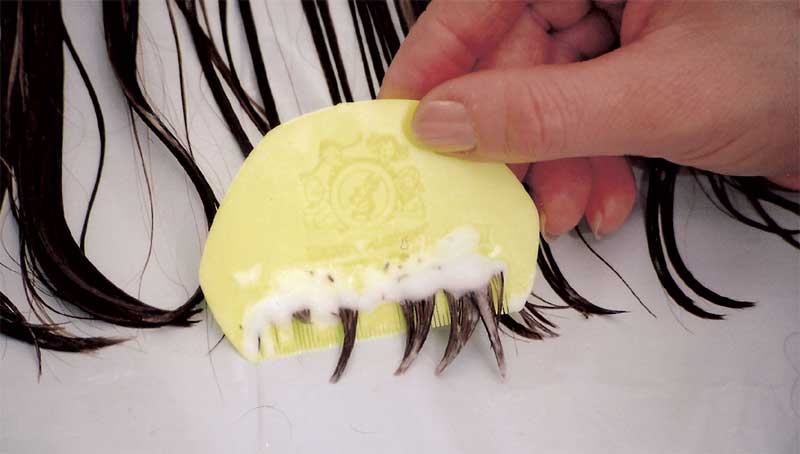Pediculosis capitis other diagnostic studies
|
Pediculosis capitis Microchapters |
|
Diagnosis |
|---|
|
Treatment |
|
Case Studies |
|
Pediculosis capitis other diagnostic studies On the Web |
|
American Roentgen Ray Society Images of Pediculosis capitis other diagnostic studies |
|
Risk calculators and risk factors for Pediculosis capitis other diagnostic studies |
Editor-In-Chief: C. Michael Gibson, M.S., M.D. [1]
Overview

The condition is diagnosed by the presence of lice or eggs in the hair, which is facilitated by using a magnifying glass or running a comb through the child's hair. In questionable cases, a child can be referred to a health professional. However, the condition is overdiagnosed, with extinct infestations being mistaken for active ones. As a result, lice-killing treatments are more often used on noninfested than infested children.[1] The use of a louse comb is the most effective way to detect living lice.[2]
Diagnosis
In cases of children with dirty, long and/or curly/frizzy hair, an alternative method of diagnosis is examination by parting the hair at 2 cm intervals to look for moving lice near the scalp. With both methods, special attention should be paid to the area near the ears and the nape of the neck. The examiner should examine the scalp for at least 5 minutes. The use of a magnifying glass to examine the material collected between the teeth of the comb could prevent misdiagnosis.
The presence of nits alone, however, is not an accurate indicator of an active head louse infestation. Children with nits on their hair have a 35-40% chance of also being infested with living lice and eggs.[2][3] If lice are detected, the entire family needs to be checked (especially children up to the age of 13 years) with a louse comb, and only those who are infested with living lice should be treated. As long as no living lice are detected, the child should be considered negative for head louse infestation. Accordingly, a child should be treated with a pediculicide ONLY when living lice are detected on his/her hair (not because he/she has louse eggs/nits on the hair and not because the scalp is itchy).[4] Misdiagnosis of head lice infestation is common. The diagnosis of head lice infestation is best made by finding a live nymph or adult louse on the scalp or hair of a person. Because adult and nymph lice are very small, move quickly, and avoid light, they may be difficult to find. Use of a fine-toothed louse comb may facilitate identification of live lice. If crawling lice are not seen, finding nits attached firmly within ¼ inch of the base of hair shafts suggests, but does not confirm, the person is infested. Nits frequently are seen on hair behind the ears and near the back of the neck. Nits that are attached more than ¼ inch from the base of the hair shaft are almost always non-viable (hatched or dead). Head lice and nits can be visible with the naked eye, although use of a magnifying lens may be necessary to find crawling lice or to identify a developing nymph inside a viable nit. Nits are often confused with other particles found in hair such as dandruff, hair spray droplets, and dirt particles. If no nymphs or adults are seen, and the only nits found are more than ¼ inch from the scalp, then the infestation is probably old and no longer active, and does not need to be treated.
References
- ↑ Pollack RJ, Kiszewski AE, Spielman A (2000). "Overdiagnosis and consequent mismanagement of head louse infestations in North America". The Pediatric Infectious Diseases Journal. 19 (8): 689–93. doi:10.1097/00006454-200008000-00003. PMID 10959734.
- ↑ 2.0 2.1 Mumcuoglu KY, Friger M, Ioffe-Uspensky I, Ben-Ishai F, Miller J (2001). "Louse comb versus direct visual examination for the diagnosis of head louse infestations". Pediatric dermatology. 18 (1): 9–12. doi:10.1046/j.1525-1470.2001.018001009.x. PMID 11207962.
- ↑ Williams LK, Reichert A, MacKenzie WR, Hightower AW, Blake PA (2001). "Lice, nits, and school policy". Pediatrics. 107 (5): 1011–5. doi:10.1542/peds.107.5.1011. PMID 11331679.
- ↑ Mumcuoglu KY, Barker SC, Burgess IE, Combescot-Lang C, Dalgleish RC, Larsen KS, Miller J, Roberts RJ, Taylan-Ozkan A (2007). "International guidelines for effective control of head louse infestations". Journal of Drugs in Dermatology : JDD. 6 (4): 409–14. PMID 17668538. Unknown parameter
|month=ignored (help);|access-date=requires|url=(help)